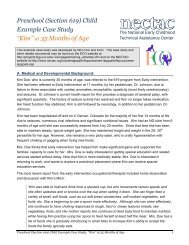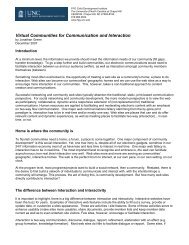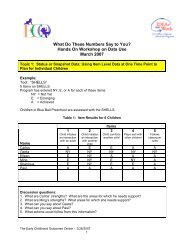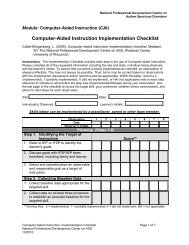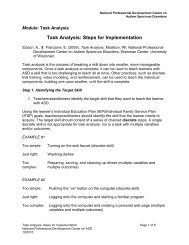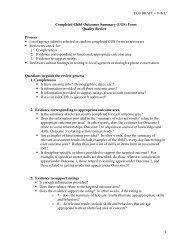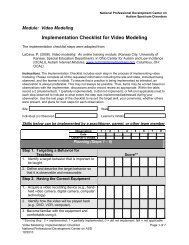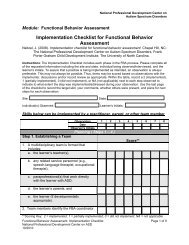Steps for Implementation: Response Interruption/Redirection
Steps for Implementation: Response Interruption/Redirection
Steps for Implementation: Response Interruption/Redirection
- No tags were found...
Create successful ePaper yourself
Turn your PDF publications into a flip-book with our unique Google optimized e-Paper software.
National Professional Development Center onAutism Spectrum DisordersModule: <strong>Response</strong> <strong>Interruption</strong>/<strong>Redirection</strong> (RIR)a. saying the learner’s name in a neutral tone of voice,b. establishing eye contact with the learner, andc. using the system of least-to-most prompts to help the learner engage in thealternative behavior.With this strategy, teachers/practitioners gradually provide increasing assistance to help alearner use an alternative behavior. The most intrusive level of prompt ensures that learnerswith ASD use the target skill successfully. Please refer to Least-to-Most Prompting: <strong>Steps</strong><strong>for</strong> <strong>Implementation</strong> (National Professional Development Center on ASD, 2008) <strong>for</strong> morein<strong>for</strong>mation about least-to-most prompting.5. For learners who engage in pica (i.e., eating non-edible items), teachers/practitionersredirect them to engage in an identified alternative behavior by:a. making a preferred food item (e.g., popcorn, goldfish crackers) freely available duringtimes when pica is most prevalent,b. saying the learner’s name in a neutral tone of voice,c. establishing eye contact with the learner, andd. using the system of least-to-most prompts to help the learner engage in thealternative behavior.EXAMPLE: A teacher places a bowl of goldfish crackers on a table in the dramatic play areaduring free play. When the learner with ASD attempts to pick up a piece of dirt off the floor andput it in her mouth, the teacher, says, “Molly, don’t,” and puts her hand in front of the learner’smouth to stop her from ingesting it. The teacher waits until eye contact has been establishedand then points to the bowl of goldfish on the table. When the learner with ASD tries to pick upanother piece of dirt and put it in her mouth, the teacher gently guides her to the table and says,“Goldfish.”6. After redirecting the learner to the alternative behavior, teachers/practitioners require thelearner to engage in the alternative behavior <strong>for</strong> a specified period of time.Teachers/practitioners initially require the learner to use the alternative behavior <strong>for</strong> a minimalamount of time (e.g., 2 to 3 seconds). As learners begin to use the alternative behavior moreoften than the interfering behavior, teachers/practitioners increase the amount of time requiredof the learner to engage in the alternative behavior (e.g., 2 minutes, 10 minutes) be<strong>for</strong>eproviding rein<strong>for</strong>cement.7. Teachers/practitioners rein<strong>for</strong>ce the learner’s use of the alternative behavior.Teachers/practitioners immediately provide rein<strong>for</strong>cement after the learner with ASD engagesin the alternative behavior <strong>for</strong> the specified amount of time. The goal of rein<strong>for</strong>cement is toincrease the likelihood that the learner with ASD will use the target skill again in the future.There<strong>for</strong>e, selected rein<strong>for</strong>cers should be highly motivating to the learner with ASD. Aslearners begin to use the alternative behavior independently, rein<strong>for</strong>cement is gradually faded to<strong>Response</strong> <strong>Interruption</strong>/<strong>Redirection</strong>: <strong>Steps</strong> <strong>for</strong> <strong>Implementation</strong> Page 7 of 8National Professional Development Center on ASD10/2010



